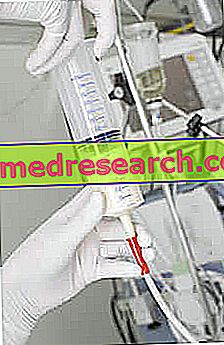Classes of drugs used in chemotherapy
Chemotherapy uses various types of drugs, which vary by target (target) and mechanism of action. Based on these two criteria, chemotherapy drugs can be classified as follows:

Alkylating agents are dose-dependent, ie the percentage of cancer cells that die is directly proportional to the amount of drug used.
They are part of this category:
- nitrogenous mustards : such as chlorambucil and melphalan, used, respectively, in the treatment of leukemia and myeloma;
- nitrosureas : like carmustine and lomustine used in the treatment of brain tumors and Hodgkin's lymphoma;
- platinum derivatives : such as cisplatin, used in the treatment of ovarian, testicular and advanced bladder cancer.
- Antimetabolites : these drugs interfere with DNA synthesis, inhibiting the formation of nucleotides (the units that make it up). If the nucleotide intermediates cannot be synthesized, DNA synthesis is permanently interrupted and tumor growth is stopped. Furthermore, many of these molecules have a structure very similar to that of endogenous nucleotides (the normal nucleotides present in the cell) and can replace them in the new DNA chain, preventing their correct formation. They are part of this category:
- 5-fluorouracil, used in the treatment of colon and stomach cancer;
- methotrexate, an inhibitor of folic acid synthesis, used in the treatment of breast, head, neck and some types of lung cancer and non-Hodgkin's lymphoma.
- Antimitotic agents : these drugs act during the phase of cell division ( mitosis ), in particular in the phase in which the newly synthesized DNA must divide between the two daughter cells. The distribution of the genetic material between the cells takes place thanks to the mitotic spindle, a complex structure consisting of particular proteins called microtubules .
Many of these drugs are derived from natural molecules that have been isolated from plants for the first time. The most well-known classes of drugs belonging to this category are Vinca alkaloids and taxanes.
- The Vinca alkaloids act by preventing the formation of microtubules and the aforementioned mitotic spindle; they can be of both natural and synthetic origin. Among those of natural origin are vincristine and vinblastine, isolated for the first time from Catharantus roseus (otherwise known as Madagascar periwinkle).
Vincristine is used in the treatment of acute leukemia and various types of Hodgkin and non-Hodgkin's lymphomas; vinblastine is useful in the treatment of advanced testicular carcinoma and Kaposi's sarcoma.
Among the synthetic derivatives is vinorelbine, used - alone or in combination with cisplatin - for the treatment of non-small cell lung cancer.
- The taxanes, on the other hand, have an opposite activity, that is they prevent the disassembly of the microtubules and the mitotic spindle. Part of this class is the natural paclitaxel molecule, isolated for the first time from the bark of a pacific conifer ( Taxus brevifolia ); It is used in the treatment of breast, lung and ovarian cancer.
Its semisynthetic derivative is docetaxel, used against breast, lung and prostate cancer.
- The Vinca alkaloids act by preventing the formation of microtubules and the aforementioned mitotic spindle; they can be of both natural and synthetic origin. Among those of natural origin are vincristine and vinblastine, isolated for the first time from Catharantus roseus (otherwise known as Madagascar periwinkle).
- Topoisomerase I and II inhibitors : topoisomerases I and II are enzymes that play a fundamental role in the winding and carrying out of the double helix of DNA during the transcription or replication of the same.
To this category of drugs belong epipodophyllotoxins, which are the semisynthetic derivatives of podophyllotoxin, a molecule that is extracted from the dried roots of the Podophyllum peltatum plant.
Epipodophyllotoxins inhibit type II topoisomerases (ie they hinder normal functioning). Among these molecules, etoposide stands out, used in the treatment of lung cancer and Burkitt lymphoma.
Type I topoisomerase is, instead, inhibited by campotecine . The progenitor of this class of drugs is the natural campotecine molecule, isolated for the first time from the bark of Camptotheca acuminata . Research conducted on this molecule has led to the synthesis of its semisynthetic derivatives, including topotecan, used in the treatment of ovarian cancer and small cell lung cancer when the first-line treatment is ineffective.
- Cytotoxic antibiotics : the antibiotics used in chemotherapy are able to block DNA transcription inducing mutations within the same and / or inhibiting fundamental enzymes involved in its replication process.
Anthracyclines are part of this category, including doxorubicin and daunorubicin.
Doxorubicin is used for the treatment of haematological tumors, solid breast, ovarian, bladder, stomach and thyroid tumors.
Daunorubicin is used to treat lymphocytic and non-lymphocytic leukemias.
The mechanisms by which anthracyclines act are multiple, since they are able to intercalate (insert) into the double strand of DNA, to generate highly reactive free radicals, which damage the molecules present in the cells, and to inhibit type II topoisomerase.
Other cytotoxic antibiotics used in chemotherapy are actinomycin, bleomycin and mitomycin.
- Actinomycin is a complex molecule able to intercalate in DNA preventing RNA synthesis. It is used in the treatment of Wilms' tumor (or neuroblastoma, a type of adrenal tumor), testicular cancer and rhabdomyosarcoma (a malignant tumor that develops in connective tissues).
- Bleomycin is a natural molecule isolated for the first time from the bacterium Streptomyces verticillus . It is able both to insert itself in the DNA and to damage it thanks to the formation of extremely reactive free radicals. It is used for the treatment of Hodgkin's lymphoma.
- Mitomycin performs the same function as alkylating agents: it therefore establishes bonds with DNA, preventing replication; moreover, it is able to produce cytotoxic free radicals. It is used in the treatment of cancer of the stomach, pancreas and bladder.
Other chemotherapeutic approaches
Hormone therapy
Hormones are used above all for neoplasms that involve sensitive organs and tissues. Examples of these diseases are estrogen-dependent breast cancer, endometrial cancer and metastatic prostate cancer, whose growth depends on the presence of sex hormones.
Antiestrogens (eg, tamoxifen), progestogens (e.g., megestrol acetate) and antiandrogens (eg, flutamide) are used to treat hormone-dependent tumors and are often used after surgery, radiotherapy and / or other chemotherapy.
Glucocorticoids (such as prednisone and methylprednisolone) are commonly administered together with anticancer agents to suppress lymphocytic activity and attempt to increase the likelihood of success in treating leukemia and lymphoma.
In other cases, hormones can be used as carriers (ie as a vehicle) for anticancer drugs; this is the example of estramustine . This drug derives from the union of a nitrogen mustard (an alkylating agent ) with the hormone estradiol; the latter is used as a vector to ensure that the drug is distributed, selectively and specifically, in the prostate tissue. Estramustine is used for the palliative care of progressive prostate cancer.
Enzymatic therapy
This type of approach involves taking enzymatic supplements as an alternative form of cancer treatment. However, there is no clear scientific evidence to prove the effectiveness of this therapy.
Enzymes are special natural proteins produced by cells, essential for the metabolic processes that take place in the body.
The first to introduce this type of approach was the Scottish embryologist John Beard in 1906, who proposed the use of pancreatic enzymes for the treatment of pancreatic cancer.
Subsequently, various researches were conducted, both in America and in Europe, but none of them was able to demonstrate the real effectiveness of the therapy.
An exception seems to be the administration of L-asparaginase (an enzyme capable of metabolizing the amino acid asparagine). This drug has been approved for use as an adjunct to other chemotherapy therapy.
Exogenous asparagine (not produced by the body but taken, for example, with food) is an essential amino acid for the growth of malignant lymphocytic leukemia cells, since these do not have the enzymes necessary to synthesize it. Healthy cells, on the other hand, possess all the enzymes necessary for its synthesis.
The therapeutic strategy consists in administering the enzyme L-asparaginase, which degrades the exogenous asparagine thus depriving the tumor cells of a molecule indispensable for them. Healthy cells, on the other hand, being able to produce it independently, manage to withstand therapy.
Future prospects
Due to the numerous and important side effects caused by chemotherapy and the increasingly frequent development of resistance to treatments by cancer cells, the search for new and innovative drugs is constantly growing.
The aim of the research is to obtain drugs that are specifically and selectively effective for malignant cells, and that are not subject to the phenomenon of multi-drug resistance.
In this regard, the so - called hybrid drugs are of particular interest. These drugs consist of a single molecule, obtained by binding together two or more drugs that all possess, or only some, anti-tumor activity. The potential advantages, compared to cocktail-based combination antineoplastic chemotherapy, can be:
- Possible reduction of toxicity;
- Better targeting of one or more components towards the therapeutic target (the target of anticancer therapy), thanks to the characteristics of one of the elements that make up the hybrid drug;
- Possible inhibition of the onset of chemotherapy resistance, while maintaining the activity of each individual component;
- Better predisposition by the patient, who must take fewer medicinal specialties.




